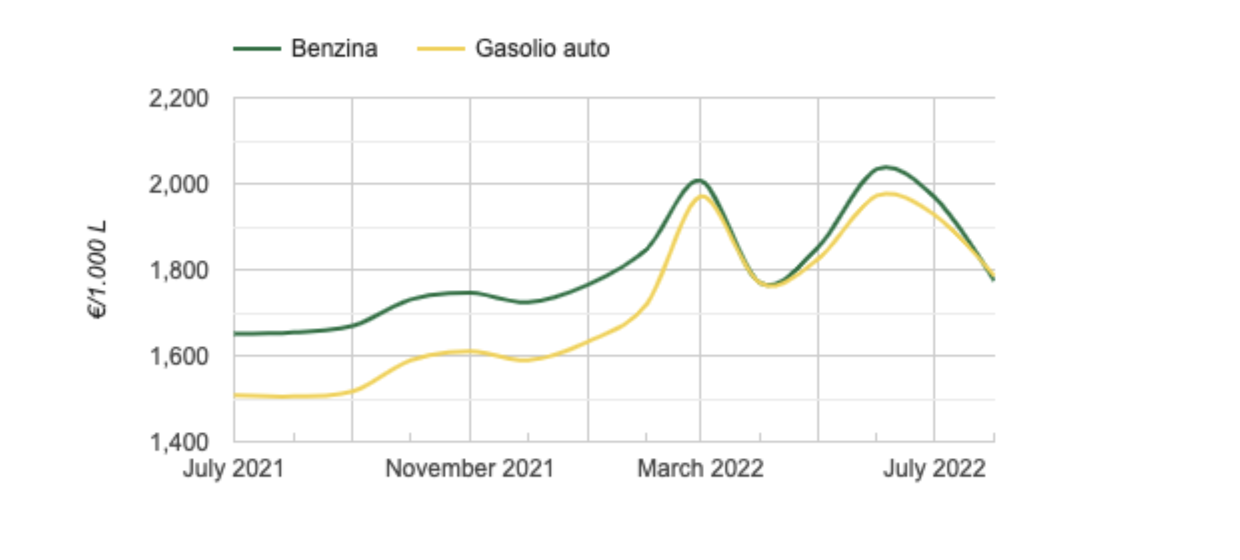It has been 7 months now that the Russian war in Ukraine has been going on, and – along with other causes1 – it is emerging as a major factor in the very high cost of gasoline and fuel in general, both globally and domestically.
Suffice it to say that Italy is the second country in the European Union (the first is Germany) that has invested more public funds to protect consumers from the impact of rising energy prices2, having allocated 49.5 billion €, an amount equal to 2.8% of its GDP3.
Some of this public money has been used to finance tax credits for energy-intensive businesses, utility bill bonuses for households and other measures, but a substantial slice has been used to cut gasoline and fuel prices at gas stations: analyzing the trend of gasoline and diesel prices over the past 12 months, two peaks can be seen, corresponding roughly to both the days before the first government decree to cut fuel prices was passed (March 2022) and the beginning of the summer tourist season (June 2022).

Source: Ministry of Ecological Transition, General Directorate of Infrastructure and Security
The impacts of these phenomena on the costs faced by transportation companies have reached a worrying intensity, and must be evaluated in light of multiple factors and different national specificities-for example, electrified vehicle traffic has an uneven distribution across Europe.
On the other hand, logistics and transportation companies have begun to implement cost-cutting strategies, even taking into account the benefits of innovative digital technologies, including fleet management telematics and route optimization software.
“The impacts of these phenomena on the costs faced by transportation companies have reached an alarming intensity, and must be evaluated in light of multiple factors.”
High fuel prices, the effects in the logistics sector
With gas prices at historic highs in many areas, the logistics and transportation sectors are particularly vulnerable to fuel cost fluctuations.
With the rising cost of gasoline and diesel fuel, the following factors may create new challenges for companies:
- Increased transportation costs: as fuel costs rise, carriers are forced to raise prices or incur losses. In turn, the cost of fuel affects not only the logistics company but also the shipper and its source of profit. Here is the domino effect: if it costs more for the carrier to transport the goods, the shipper will have to pay more to offset this cost. If the shipper has to pay more to transport the goods, the consignee will have to pay more to offset the additional cost. In short, the cost of fuel affects the entire industry.
- Inflation:as the cost of fuel affects all aspects of the transportation sector, product prices are also expected to rise. As economic systems fluctuate, it may be necessary to charge a slightly higher price for the product to make the same profit. Shipping some items, such as temperature-controlled products, will cost more than others. In essence, rising fuel costs cause product inflation and affect every aspect of transportation.
- Reducing transportation service utilization levels: if the cost of fuel rises significantly for a sustained period, companies in many industries will have to work hard to maintain their profits. One way to do this is to cut services or switch to more cost-effective services. Transportation services that were once popular may experience a small decline, for example, as companies seek to reduce additional expenses.
- Shifting service areas: fuel prices set at a certain level will also cause some carriers to change the areas where they are willing to transport products. The optimal service area, or the most convenient distance to transport a product, is subject to relocation as a result of any kind of economic instability. As a result, rising fuel prices can be an obstacle to convenient transportation. This problem is particularly acute for products that must be shipped long distances from the manufacturer or company.
“These phenomena in turn have effects on transportation modes.”
What strategies to undertake? How to reduce costs?
As it becomes less and less economically viable to move goods using fuel inefficient methods, transportation modes are changing.
For example, if the cost of using rail is low and the cost of gasoline and diesel fuel is high, a logistics company may ship more goods by intermodal carriers than by truck.
According to the U.S. Department of Transportation, which cites a study by the Association of American Railroads4, trains are four times more fuel efficient than trucks and can move 1 ton of product about 800 km (500 miles) with less than 4 liters (1 gallon) of diesel fuel. Because of this greater efficiency, the fuel required is a smaller percentage of the total operating cost than other methods. This allows companies to save money and achieve higher margins, providing a new opportunity for many who in the past would have looked elsewhere.
More is happening in the shipping industry: already struggling with higher costs due to supply chain issues such as lack of port and storage space, shipping costs are rising further due to current fuel prices. Often distinguished from other methods for low cost and higher margins, companies are beginning to look elsewhere as profit potential becomes increasingly difficult.
As we have seen in the case of trucking, ocean carriers are offsetting these costs with surcharges, since fuel makes up most of the total cost. In addition, many carriers practice "slow sailing" on ships. This is a process of reducing speed (often to about 15 knots, rather than about 22 knots) to reduce fuel consumption, similar to the way trucking companies adjust the maximum speed of trucks to reduce fuel consumption. While this cost mitigation strategy slows down already exasperated shipping times, it also reduces costs and emissions for carriers.
Finally, let's look at 4 strategies to reduce costs.
Partner with a telematics provider
Fleet management softwares allow you to monitor GPS location and vehicle performance, and maintain driver safety. They can track drivers' routes and patterns, ensure greater operational efficiency and more control over transport operations, suggest the most optimal routes based on delivery rounds, and monitor fuel consumption and other parameters. The technology also helps optimize the time spent planning delivery routes and save on back office operations costs. It also improves drivers' work experience, enables more error-free deliveries, and reduces mileage and CO2 emissions. Partnering with a telematics and route optimization technology provider will ensure that vehicles are equipped with the systems best suited to business needs.
Keep tires properly inflated
According to a report by the National Highway Traffic Safety Administration and the U.S. Department of Energy5, ensuring that vehicles have properly inflated tires can improve fuel efficiency by an average of 0.6% to 3%.
Because outside temperatures affect commercial vehicle tire pressures, drivers should check tire pressures regularly for changes in weather and temperature: tire pressures can change significantly in both cold and very hot climates. Drivers and maintenance professionals should check tire pressure before trucks go out on the road and as part of regular maintenance.
Avoid idling
Vehicles that are started more often during the day consume more fuel than those that are started less often. At the same time, idling vehicles waste fuel unnecessarily and accumulate unnecessary costs. These wasted expenses can add up across the fleet and be a significant detriment to profits.
Drivers should be instructed to turn off their engines if they plan to be parked or stationary for a while. This will result in short- and long-term economic savings in fuel consumption and engine wear. Drivers should also shift gears earlier to lower the overall RPM, which can also reduce fuel consumption.
Set speed restrictions for drivers
Speeding wastes fuel and is potentially dangerous, especially for truck drivers. According to generally accepted studies, high-speed driving can reduce fuel efficiency by up to 30 percent. Speed limits should be agreed with drivers to reduce fuel consumption and safety risks.
Conclusions
The impacts of the high cost of gasoline and fuels in general on the costs faced by transportation companies have reached a worrisome intensity, and are increasingly prominent in risk factor analyses produced by organizations.
With gas prices at historic highs in many regions of the global economy, the logistics and transportation sectors are particularly vulnerable to fuel cost fluctuations.
Digitization and innovative logistics technology solutions can certainly help mitigate the risks and costs of delivery rounds, while generating real-time transportation visibility to boot.
Notes
1. See the article by New York Times titled Why Gas Prices Are So High
2. See the article by Europa Today titled Aiuti pubblici contro il caro bollette: in Europa solo la Germania ha speso più dell'Italia
3. See the report by Bruegel titled National policies to shield consumers from rising energy prices
4. Association of American Railroads, Freight Rail & Preserving the Environment, May 2022
5. See the report titled Keeping Your Vehicle in Shape

